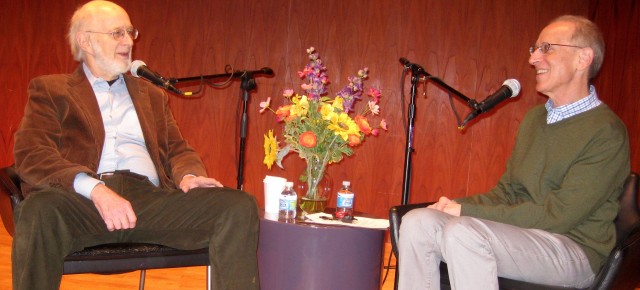|
The invitation was an honor – to be interviewed by Randy Cohen on his radio/podcast show, PersonPlaceThing.
Everybody knows Cohen, the original Ethicist in the New York Times magazine, who set such a high bar of being informed, quirky and timely. Now he produces his own show, asking people to discuss their favorite person, place and thing. His invitation included a podcast of his interview with Judy Collins. On the same list as Judy Blue Eyes? Count me in. Cohen’s show took place at the beautiful library in Port Washington, L.I., in front of friends, neighbors and family, facilitated by the ever-personable Jessica Ley. For my choices, I could have gone stone serious but I decided to omit family, religion and politics. Better to go with the first answers that popped into my head – stuff that sustains me, at this stage in my life, outside my deepest ties. Cohen did a great job editing nearly an hour of banter into a tight 25 minutes but I do have a footnote to each category: Person: The tense original first chapter to which I refer is about a confrontation between Confederate soldiers and two teen-age brothers on a road leading to Gettysburg. The famous editor was flat-out wrong to cut it. The author was right. That scene, now restored, sets up the entire novel. Place: I love my adopted home town but I also love my home borough of Queens. Living half an hour east is about as far as I can stand. That helps explain my choice. Thing: Cohen’s subtle editing cut out the fact that he is far more accomplished than I am with my chosen implement. I have immense respect for his weekend jaunts. Nuff said. I’ll be proud if anybody wants to listen and respond in Comments. * * * The link to the show: http://personplacething.org/episode-161-george-vecsey/ The show will also be broadcast in New York on Tuesday at 1:30 PM on WNYE, 91.5 FM, and more broadly Friday night at 10:30 PM across WAMC Northeast Public Radio. You can also download it free at iTunes.
Altenir Silva
3/7/2017 05:35:51 am
Dear George,
George Vecsey
3/7/2017 12:49:34 pm
Dear Altenir: Thanks for listening to the interview. I don't know how Ella came to be on the audio -- but I am now conditioned to listen for her. We've been there 30-40 times in the past five-six years. It is so familiar. Now they seem to have the occasional Indian film, also. No idea how this very cool place comes to exist. But it does. Best, GV Comments are closed.
|
Categories
All
|










